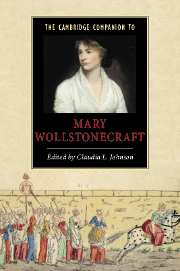Book contents
- Frontmatter
- 1 Introduction
- 2 Mary Wollstonecraft's letters
- 3 Mary Wollstonecraft on education
- 4 Mary Wollstonecraft's Vindications and their political tradition
- 5 Mary Wollstonecraft's French Revolution
- 6 Mary Wollstonecraft's literary reviews
- 7 The religious foundations of Mary Wollstonecraft's feminism
- 8 Mary Wollstonecraft and the literature of advice and instruction
- 9 Mary Wollstonecraft's A Vindication of the Rights of Woman and the women writers of her day
- 10 Mary Wollstonecraft and the poets
- 11 Mary Wollstonecraft's novels
- 12 Letters Written During a Short Residence in Sweden, Norway, and Denmark: traveling with Mary Wollstonecraft
- 13 Mary Wollstonecraft and the sexuality of genius
- 14 Mary Wollstonecraft's reception and legacies
- Select bibliography
- Index
5 - Mary Wollstonecraft's French Revolution
Published online by Cambridge University Press: 28 May 2006
- Frontmatter
- 1 Introduction
- 2 Mary Wollstonecraft's letters
- 3 Mary Wollstonecraft on education
- 4 Mary Wollstonecraft's Vindications and their political tradition
- 5 Mary Wollstonecraft's French Revolution
- 6 Mary Wollstonecraft's literary reviews
- 7 The religious foundations of Mary Wollstonecraft's feminism
- 8 Mary Wollstonecraft and the literature of advice and instruction
- 9 Mary Wollstonecraft's A Vindication of the Rights of Woman and the women writers of her day
- 10 Mary Wollstonecraft and the poets
- 11 Mary Wollstonecraft's novels
- 12 Letters Written During a Short Residence in Sweden, Norway, and Denmark: traveling with Mary Wollstonecraft
- 13 Mary Wollstonecraft and the sexuality of genius
- 14 Mary Wollstonecraft's reception and legacies
- Select bibliography
- Index
Summary
When the fall of the Bastille on 14 July 1789 signaled to the world that something extraordinary was taking place in France, Mary Wollstonecraft was already in a position, intellectually and socially, to respond with enthusiasm. From 1784 to 1785 she had lived in Newington Green, where she came under the influence of the Dissenting preacher Dr. Richard Price, then in his sixties, who was one of the leading radical intellectuals of the day. In 1787 she began working as a writer and translator for Joseph Johnson, a Dissenter and radical publisher whose home and bookshop at St. Paul's Churchyard was a focal point for London Dissenters and radicals. As a kind of surrogate daughter to Johnson, Wollstonecraft became part of one of the most forward-looking intellectual circles in Britain. Members of Johnson's circle hurried to Paris in the summer of 1789 and returned with enthusiastic accounts, hoping that a similar revolution might take place in Britain. The joy occasioned by the French Revolution's early phase bound this circle together, as Claire Tomalin puts it, “in the certainty that they knew the truth and that it was bound to prevail.”
The French Revolution was a drawn-out process rather than a single event. But the dramatic events of the Revolution’s early phase provoked one of the most important political debates in British history. The “Revolution Controversy” of 1789–95 was as much about the implications of the Revolution for Britain as it was about the Revolution itself.
- Type
- Chapter
- Information
- The Cambridge Companion to Mary Wollstonecraft , pp. 59 - 81Publisher: Cambridge University PressPrint publication year: 2002
- 5
- Cited by



